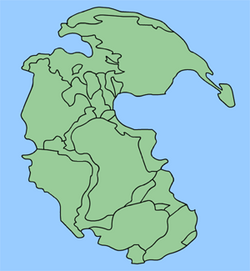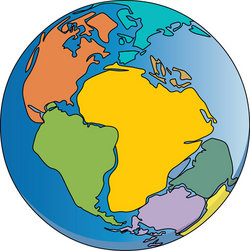Pangaea
|
|
Pangaea (Greek for "all lands") is the supercontinent that existed during the Mesozoic era, before the process of plate tectonics separated the component continents. The name was coined by Alfred Wegener in 1915. When the continents first came together to form Pangaea about 300 MYA, mountains were formed, and some of these ranges still exist, such as the Appalachians, the Atlas Mountains, and the Urals. The vast ocean that surrounded Pang�a has been named Panthalassa. Pangaea broke up about 180 million years ago.
Pangaea was a C-shaped landmass that spread across the equator. The body of water that existed within the "C" has been named the Tethys Sea. Because Pangaea was so big, the inland was very dry due to the lack of precipitation. The large continent would have allowed land animals to migrate all the way from the South Pole to the North Pole.
The mantle under Pangaea's former location was still hot and trying to rise upward. As a result, Africa sat several tens of meters higher than the other continents.
Pangaea was probably not the first "supercontinent." It's believed that Pannotia formed about 600 MYA and split up 550 MYA. Also, Rodinia had formed approximately 1,100 MYA and divided 750 MYA.
During the Jurassic period, Pangaea broke into two parts: a southern part, Gondwana, and a northern part, Laurasia.


